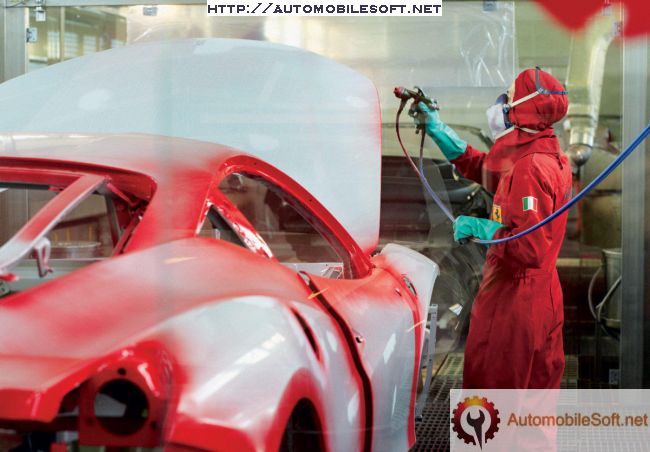Essentially
- ♦
- Car paint is usually composed of 3 layers.
- ♦
- Over paint may be add up to 5 additional layers of protection.
- ♦
- New cars are painted electrostatically
[Most of the times, your car paint is overlooked and considered an element of the automobile that does not require attention. Nothing could be more wrong though.]The vehicles were painted since their existence from 1875. Even the steam vehicles, made a century before were painted. That’s because the world has realized that the metal rusts unless it is protected. Obviously, we can not compare the techniques of dyeing from 2 or 3 centuries ago with to those of nowadays, but automotive paints role remains the same: protection of metallic surfaces. Besides this role, paint which is now proposed in hundreds of shades and colors, also acts as aesthetic customization of the car. If in 1904, automobiles were sold only in black, today, only one brand can have in the list of options more than 80 different shades.
The paint our machines however is made after complex processes. We take it for granted, and say that the car is “red” or “blue” and we are not interested in something else. But things are not at all simple with cars paintwork. Because the paint is perhaps the most ‘tormented’ element that any car it holds.

Paint Chart
From what is made automobile the superb paint?
Modern cars have bodies and body elements covered with 4 layers of paint. Each of these layers has a specific role, of protection, of adhesion for the next layer, or purely aesthetic. In total, for painting a car with a midsize sedan body, are used between 10 and 15 liters of paint. Finally, after drying, the 4 layers will have a gathered thickness of 100-110 microns. That is a tenth of a millimeter, exactly the thickness of a human hair.
Custom Colors
Below are some color samples of paint for cars.
[The 4 layers of auto paint which is applied in our days are: The cathode layer, Primer, Basecoat and the Clearcoat. Each of these 4 layers is applied one at a time using special robots or following the sinking of the body or parts in a bath of solution]
Car colour popularity
The favourite automobile tones these days are shades of grey: white, black, grey and metallic, amounting to over 70% of the entire globe auto manufacturing. Red, blue and brown/beige vehicles range among 6% and 9% each, while all the other colors end up lower than 5%. Colour option is susceptible to fluctuation and style, and historic tendencies moved from black neutral colours of first vehicles, through more intense colors of 50s and 60s, back again to the today’s neutral colours.
[Usa paint companies PPG Industries and DuPont each perform yearly studies around automobile colour popularity global.]
Slightly more men compared to women chosen red, while slightly more women compared to men preferred silver. It is most likely not coincidental that the top rated 3 male-preferred shades (red, orange and black, each one having identical proportions) are very desired colours for sports cars, automobiles which often find more favor amongst men than women.
Automotive paint processes
[Automotive paint is paint used on automobiles.]Phases
- 1
- Pre Clean Process
- 2
- Phosphate
- 3
- E-COAT
- 4
- Primer
- 5
- Basecoat
- 6
- Clearcoat
The sun, the greatest enemy of car paint
Even though today cars are equipped with the smartest and performant paints, over time, sun is most harmful for our car. On a warm summer where outside are 40 degrees in the shadow, car body surface may even reach 90-100 degrees. This temperature is higher in the engine area meaning on the hood and the front wings.If we take care of our car and wash it regularly, we should not worry that we will have trouble with the paint even at high temperatures during summer. But those who are really interested for own car exterior condition are quite few. When it is very hot, gravel or small dust particles easily penetrate the paint, especially if we drive fast on roads full of stone chippings. The layers of paint are specially designed to withstand high temperatures, but becomes softer and more brittle when the temperature is very high. Ie during summer, pebbles thrown on the road will do greater damage.
If we do not wash the car, we have another problem: accumulated dust, hundreds of insects and bird droppings begin to act on the paint lake and can even reach the basecoat. Unfortunately, because we live in crowded cities, we can wake up anytime with various chemical solutions thrown on the car, plenty of dust rich in pollutants, car oil threw by dump truck which pull off a lot of smokes, gas and so on.
[Washing the car is not a fad, but a prevention measure by eliminating various substances that may affect the paint.]



Barney Harrison
Hello there! I simply would like to give you a big thumbs up for the nice information about paint color you have got right here on this single post. I will be returning to your site for more soon.
L Frame
Can car/automobile paint be applied to veneer & wood without harming them?? Example: organ or piano consoles
Eton Messy
Great mix, thanks for supporting chameleon paint.